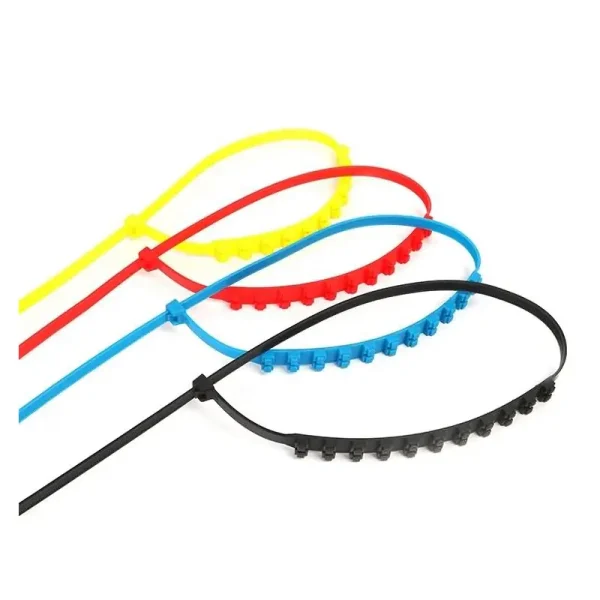Cable ties , also known as cable ties or cable ties, are a widely used tool for bundling and organizing wires, cables, pipes, and other things. Because of the simplicity and durability of their nature, they find wide application in homes, offices, industries, and many other places. What, then, are cable ties made of? In this article, we go deep into the main components and advantages of cable ties.
Polyamide (Nylon)-Cable Ties’ Main Material
The vast majority of cable ties are manufactured from polyamide, popularly known as nylon. Nylon is a very strong facing synthetic material that has good resistance to wear and tear and is tough; it is chemical-resistant, too, which enables cable ties to act excellently in a wide range of environments.
Temperature resistance of high and low degree: nylon cable tie can work in a very wide range of temperatures; ordinary nylon cable ties usually work at a temperature from -40 to 85, while some formula specifically prepared cable ties such as high temperature resistant nylon cable ties can work at a high temperature.
UV resistance: Nylon itself has poor resistance to UV rays. So most cable ties will add in the UV stabilizer during production processes to improve the service life of the cable tie outdoor or in direct sunshine.
Chemical resistance: Nylon cable ties can resist the erosion of a lot of common chemicals (like oils, solvents, etc.) and also face up to different kinds of industrial environments.
Polyester (PET) – To enhance weather resistance and strength
In addition to nylon, some cable ties also use Polyester (PET) materials, especially in applications that require additional strength, weather resistance, and UV resistance.
Corrosion Resistance: Polyester cable ties are excellent in corrosion resistance under harsh conditions and for some environments with more chemicals or higher humidity.
UV Resistance: Usually, polyester cable ties have high UV resistance and are suitable for long-term sunlight exposure, especially outdoor applications.
Strength and stability: Polyester materials are comparatively hard, cable ties have high tensile strength, so they can perform excellently in scenes with high bearing requirements.
Polypropylene (PP) – A More Economical Choice
Polypropylene (PP) is another material in general use for manufacturing cable ties. Although the strength and resistance to high temperatures are not as good as nylon and polyester, it has other unique advantages:
Lightweight: The polypropylene cable ties are light and suitable for applications without requiring high loading.
Chemical resistance: Most acids and bases have weak effects on polypropylene; thus, it is suitable for some chemical environments.
Economical: The production cost of polypropylene is low; thus, the produced cable ties are relatively cheap and suitable for large-scale use.
Stainless Steel Cable Ties – High Strength and High Temperature Resistance
Stainless steel cable ties are widely used in applications that require super high strength or resist high-temperature environments. They are normally made up of stainless steel bands and plastic locks. Some of the features are as follows:
Ultra-high strength: Stainless steel cable ties possess extremely high tensile strength and can bear higher loads.
High-temperature resistance: Stainless steel cable ties can bear high temperatures and are suitable to be used in high-temperature surroundings, such as furnace pipes and water heaters.
Corrosion resistance: Stainless steel has extremely high corrosion resistance, and is especially suited for use in ocean or chemically-corrosive environments.
Other special materials
Apart from the usual nylon, polyester, and polypropylene, some cable ties use other special materials to achieve certain specifications, such as:
Silicon or rubber cable ties are suitable for the purpose when a soft, elastic, and well-sealed application is involved.
Wire cable ties find application where extra strength and durability become essential, and thus generally see applications in large machinery and equipment or industrial applications.
Konklusion
In general, the basic material for cable ties is nylon, widely used because of its high strength, good durability, and moderate cost. For special environmental requirements, there are also polyester, polypropylene, stainless steel, and other materials. Each material has different performances, and users can choose proper cable tie material according to specific usage requirements.
Understanding the composition and performance of cable ties could help us better choose suitable products to ensure they can work stably for a long time in a specific environment.
Related Products
Anti-slip til bildæk Kraftige lynlåsbånd af plast
Product Name:Car Tire Anti-Slip Heavy Duty Zip Ties Plastic Brand:JYIELE Material: new nylon 66 Size: 12*900 MM Width: 175-195 MM Weight: 0.8kg Applicable wheel size: 14-24 inches (not applicable to truck wheels and drum wheels) Operating temperature: -35°C to 85°C…
Kabelbindere i plast
JYIELE produces plastic ties with complete specifications, strong and durable, easy to operate, and widely applicable, making it an ideal supplier for you in a variety of fixing needs

